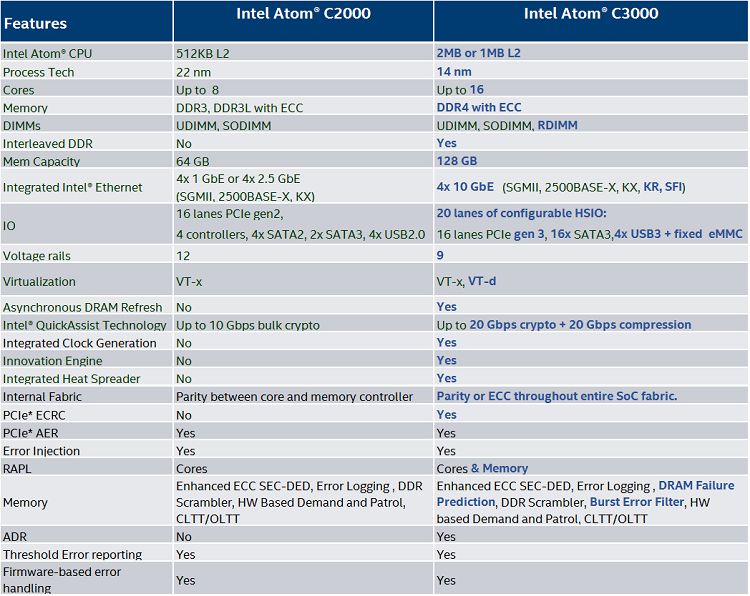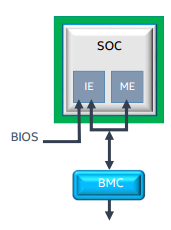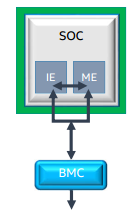Executive Summary
The Intel Atom® processor C3000 product family, formerly code named Denverton, is Intel’s third-generation 64-bit server system-on-chip (SoC) and is manufactured using the Intel low-power SoC 14 nm process, with up to 16 cores and 8.5–32 watts of power consumption. In addition, the Intel Atom processor C3000 product family includes an extension of the base product line focused on communications.
The data center environment is diversifying, both in terms of infrastructure and market segments including storage, communications, cloud, HPC, and traditional enterprise. Each area has a unique requirement which provides an opportunity for targeted solutions to best cover these needs. The Intel Atom processor C3000 product family extends Intel’s existing portfolio of products that service the cloud service providers. The Intel Atom processor C3000 product family is optimized for parallel software that benefits mostly from more individual servers with sufficient I/O between nodes including static web servers, cold storage, network routing, entry level storage area network/network attached storage (SAN/NAS), entry level software-defined networking/network functions virtualization (SDN/NFV), entry level control plane within switches, line cards, WLAN controllers, distributed memory caching (memcached), simple content delivery node, and any of the aforementioned uses that have an additional need for acceleration of cryptographic communications such as entry level security appliances and switches.
Microserver Overview
The microserver comprises multiple Intel Atom® processor C3000 system-on-chip (SoC) nodes sharing a common chassis, fans, and power supplies, and is interconnected to achieve improved flexibility, higher efficiency, and optimization of rack density. Microservers based on Intel Atom processor C3000 SoC nodes can meet different usage models, such as combining with lots of disk storage to provide a cold storage solution, or to provide a low power, high density network solution.

Figure 1. Generic, high-level overview of how a microserver chassis is composed of multiple SoC nodes, along with shared components (such as power supply, fans, and chassis).
SoC Architecture Overview

Figure 2. High-level diagram of the Intel Atom® processor C3000 product family microarchitecture.
Intel Atom Processor Network Series
The Intel Atom processor C3000 product family has a subset of server products that include enhanced communications features. This communications-focused product line extends the base Intel Atom processor C3000 product family with a communications reliability profile, longer product lifecycle, and integrated Intel® QuickAssist Technology to accelerate cryptographic workloads. The product models that have some or all of the additional communications capabilities can be identified by an 8 at the end of the product model number (that is, C3958, C3858, and so on).
The enhanced communications features are made possible through innovations in software and hardware. The Intel QuickAssist Technology hardware, when combined with software optimized with the Data Plane Development Kit (DPDK), provides acceleration for communications workloads.
For more information, see Intel QuickAssist Technology or Data Plane Development Kit.
Intel Atom® Processor Family Generation Comparison
The Intel Atom processor C3000 product family provides advantages over its predecessor, the Intel Atom® SoC C2000 product family, formerly code named Avoton and a communications-focused SKU code named Rangeley by adding cores, a larger cache size, greater memory capacity, and speed.

Figure 3. Generational families.

Table 1. Generational comparison (enhancements and new features highlighted in blue).
Intel Atom® Processor C3000 Product Family Overview
The rest of this paper discusses in greater detail some of the new features in the Intel Atom processor C3000 product family.
Architecture
Several new or enhanced architecture features have been added to the Intel Atom processor C3000 product family. At the core level, Intel® Turbo Boost Technology is supported on some processor models, and per-core power gating is supported on all models providing a more optimized approach of balancing performance and power requirements. The core count has been increased versus the previous generation and the L2 cache size has been significantly increased. The architecture was designed with out of band (OOB) access to both the core and uncore Machine Check Architecture (MCA) registers, while Intel Atom processor C2000 product family only supported OOB access to the uncore registers. There have also been improvements with instruction fetch/decode functions, branch prediction, out of order scheduling, and cache miss processing. Enhancements to the memory architecture provide support for faster 2400 DDR4 memory and expanded memory capacity, and adds support for memory interleaving.
The product line is compatible with the Intel® Xeon® processor instruction set architecture (ISA) and also supports the Intel® Streaming SIMD Extensions (Intel® SSE 4.1/Intel SSE 4.2). Intel SSE are a SIMD (single instruction, multiple data) instruction set extension to the x86 architecture for Intel® processors. Intel SSE instructions work primarily on single-precision floating-point data, increasing performance when the same operations occur on multiple datasets. Applications that typically benefit from this technology would be those associated with digital signal processing.
Virtualization
Intel® Virtualization Technology combines with software-based virtualization solutions to provide maximum system utilization by consolidating multiple environments into a single server or PC. By abstracting the software away from the underlying hardware, new usage models open up that can reduce costs, increase management efficiency, and strengthen security, while making your computing infrastructure more resilient in the event of a disaster. The following virtualization capabilities have been included with the Intel Atom processor C3000 product family.
Intel Virtualization Technology (Intel® VT) for IA-32, Intel® 64 and Intel® Architecture (Intel® VT-x) was previously included on the Intel Atom processor C2000 product family and support for this is continued on the Intel Atom processor C3000 product family. However, virtualization support has been expanded further to include Intel Virtualization Technology (Intel VT) for Directed I/O (Intel® VT-d). Intel VT-d focuses on virtualization of directed I/O, which includes dealing with aspects of I/O device assignment, DMA remapping, interrupt remapping, and reliability features. In the case of the Intel Atom processor C3000 product family it provides optimizations with the virtualized I/O and supports Peripheral Component Interconnect-Special Interest Group* Single Root I/O Virtualization (PCI-SIG* SR-IOV). The Single Root I/O Virtualization and Sharing Specification defines extensions to the PCI Express* (PCIe*) specification suite to enable multiple system images (SI) or virtual machines (VMs/guests) in the virtualized environment to share PCI hardware resources. Thus, network-centric virtual machines can benefit from these enhancements.
Intel® QuickAssist Technology
Intel® QuickAssist Technology (Intel® QAT) accelerates and compresses cryptographic workloads by offloading the data to hardware capable of optimizing those functions. This makes it easier for developers to integrate built-in cryptographic accelerators into network, storage, and security applications. In the case of the Intel Atom processor C3000 product family only select models have this integrated capability (see the section titled Intel Atom Processor Network Series).
For cryptographic usage models such as in the case of network security (IPsec, SSL/TLS), hashing for data-deduplication or encrypted storage, the following is supported:
Symmetric (Bulk) Cryptography
Ciphers (AES, 3DES/DES, ARC4*, KASUMI*, SNOW 3G*).
Message digest/hash (MD5, SHA1, SHA2, SHA3) and authentication (HMAC, AES-XCBC).
Algorithm chaining (one cipher and one hash in a single operation).
Authenticated encryption (AES-GCM, AES-CCM).
AES-XTS.
Wireless
KASUMI, SNOW 3G and ZUC.
Asymmetric (Public Key) Cryptography
Modular exponentiation for Diffie-Hellman (DH).
RSA key generation, encryption/decryption and digital signature generation/verification.
DSA parameter generation and digital signature generation/verification.
Elliptic curve cryptography: ECRSA, ECDH.
Random Number Generation
Supported with rd_rand and rd_seed instructions.
For data compression usage models such as in the case of WAN acceleration, storage/database compression, and http compression, the following are supported:
Compression and Decompression Using the Following Algorithms.
DEFLATE: LZ77 compression, followed by Huffman coding, with a gzip or zlib header.
Other Features
Dynamic and static Huffman Trees.
Four search depths (1, 4, 8, 16).
Support for stateful compression and decompression.
Multiple history sizes with deflate.
For additional information on enabling and support, see Intel QuickAssist Technology.
Ethernet
The Intel Atom processor C3000 product family includes an integrated Intel® Ethernet Controller that can provide up to a total of four 10 GbE ports, with up to 20 Gbs full duplex throughput on the platform that is split between the four ports. Adaptive power management, which is compliant with the IEEE* 802.3az standard, provides energy efficiency during low energy consumption states such as during idle periods. The Intel Ethernet Controller also supports PCI-SIG SR-IOV (see the section titled Virtualization), unified networking through the data center bridging (DCB) for deploying Internal Small Computer Systems Interface (iSCSI) or network attached storage (NAS) over Ethernet, and BMC capability for easier manageability of the platform.
Flexible I/O Adapter
The Intel Atom processor C3000 product family utilizes an exciting feature where up to 20 high speed I/O (HSIO) lanes pass through a Flexible I/O Adapter (FIA) within the SoC. The HSIO lanes can be mapped to different controllers (PCIe, SATA, or USB) based on the customization needs of the end user to fit their usage model. These HSIO lanes can be statically configured through soft straps or can be configured through the BIOS (requires a reset).
The Innovation Engine
The Innovation Engine (IE) is an embedded core within the SoC. It is similar to Intel® Management Engine (Intel® ME), with some privilege and I/O differences. The IE is designed to assist original equipment manufacturers (OEMs) in providing a more secure form of the Intel ME. IE code is cryptographically bound to the OEM, and code that is not authenticated by the OEM will not load. The system can operate normally without having to activate IE because it is an optional feature.
For cloud and embedded segments the basic manageability without cost, space, or power of a BMC can be attractive. The IE runs simple management applications (for example, Intelligent Platform Management Interface (IPMI)) and network stack for out of band operations.

Figure 4. BMC-less manageability for lightweight requirements.
For the enterprise segment, IE can be of value for improving system performance by reducing BMC round-trips or SMM interrupts on the CPU. IE runs OEM-specific BMC- or BIOS-assist software.

Figure 5. BMC- or BIOS-assisted configuration.
For more in-depth enterprise-level needs, IE and ME can work together to provide new or enhanced usage models using telemetry and controls provided by Intel. The IE can communicate with the ME to pull in telemetry data and provide additional processing capability.

Figure 6. IE provides enhancement to Intel® ME firmware.
The Author: David Mulnix is a software engineer and has been with Intel Corporation for over 20 years. His areas of focus has included software automation, server power, and performance analysis, and he has contributed to the development support of the Server Efficiency Rating ToolTM*
Resources
Intel Instruction Set Architecture Extensions.
Energy-efficient Intel® microservers.
Intel® QuickAssist Technology.
Intel® Virtualization Technology (Intel® VT) for Directed I/O (Intel® VT-d).